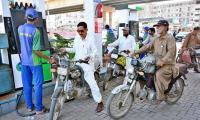PESHAWAR: The district administration has failed to protect the heritage structures such as the historic City Wall and various gates in the provincial capital that are being used by the political parties to display election banners.
The Town-I officials had written to Peshawar Deputy Commissioner Imran Hamid Sheikh almost two weeks back to ban display of banners at historical places.
They had suggested the imposition of Section 144 to protect the archaeological and historical sites in the Walled City, which are being damaged as various political have displayed election banners on these heritage structures. However, the letter was never taken seriously.
When approached by The News, Town-I Nazim Zahid Nadeem confirmed that two weeks back he had written a letter to the district administration for the imposition of Section 144 to ensure non-display of election campaign banners and posters on the historical gates and other archaeological sites.
He argued that these places were an asset of Peshawar city and steps should be taken to protect the heritage sites from encroachments and subsequent damage.
“The imposition of Section 144 is a must to protect public properties from any damage. These were bequeathed to us by our elders and we are supposed to protect them,” he said.
Zahid Nadeem pointed out that historical and landmark buildings were physical links to the past that should be preserved for posterity.
He said the government should take immediate steps to protect all the gates, the famous Ghanta Ghar and all other cultural landmarks within the Walled City.
When asked whether the district or town governments had contacted the Election Commission of Pakistan (ECP) to this effect, he said the local government had no communication channel with the ECP. He added that should be done by the district administration.
It may be mentioned here that ECP issued a code of conduct for the general election on June 14, 2018.
The Point 25 of the 86-point code of conduct states: “In no case, the political parties, contesting candidates, election agents or their supporters shall affix posters on walls or any buildings.”
It has been observed that some candidates are violating the very code by displaying election campaign banners and posters on gates of the walled city despite the ban.
Nawazuddin, a research officer at the Directorate of Archaeology and Museums, told The News that his department was responsible for the historical sites while the rebuilt structures were the responsibility of the district government and administration. He said historical gates and Ghanta Ghar fell under the responsibility of the Archaeology Department. He insisted that his department would take action in case of any violation.
A visit to the various localities by this scribe on Friday, however, showed that large-size election banners and flags of various political parties had been displayed at the Aasya Gate and Sard Chah Gate. Both the gates are present in their pristine form even though these were constructed in 1903 and 1904, respectively.
The banners and flags are also marring the beauty of other gates which were reconstructed from 2008 to 2013. The reconstruction initiative was taken by the then minister from Pakistan People’s Party (PPP), Syed Zahir Ali Shah. He released funds to rebuild Gunj, Lahori and Hashtnagri gates. He also fixed signboards at various bazaars and mohallas bearing the old names of the localities. A minister from the Awami National Party (ANP), Bashir Bilour, before he was martyred in a bomb explosion took forward the step and got reconstructed the remaining old city gates.
Attempts were made by this scribe to seek comments from Deputy Commissioner Imran Hamid Sheikh, but he neither took the calls nor replied to the text messages seeking his comment.







